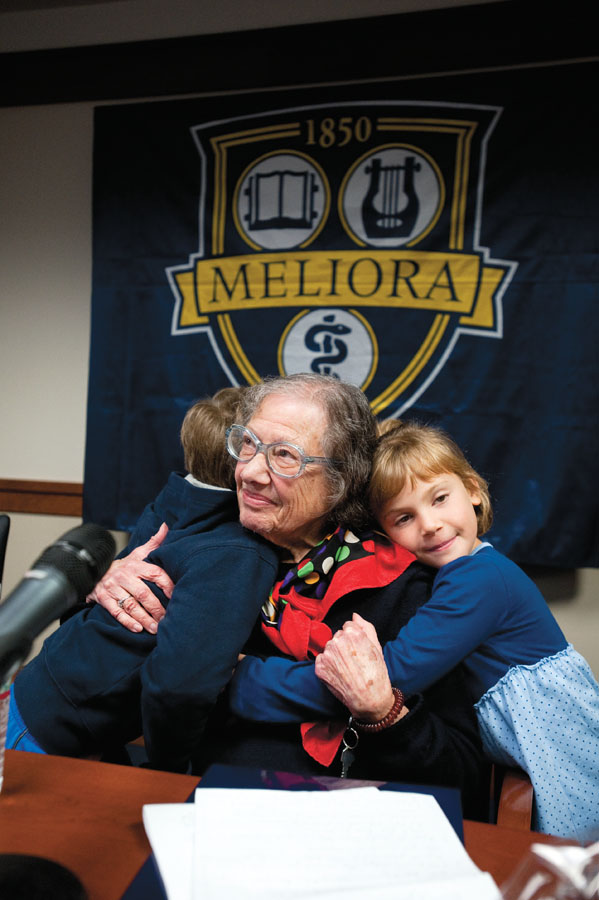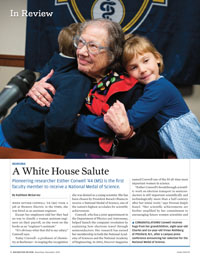In Review
 CONGRATULATIONS! Conwell receives hugs from her grandchildren, eight-year-old Charles and six-year-old Vivian Rothberg of
Pittsford, N.Y., after a campus press conference announcing her selection for the National Medal of Science. (Photo: Adam Fenster)
CONGRATULATIONS! Conwell receives hugs from her grandchildren, eight-year-old Charles and six-year-old Vivian Rothberg of
Pittsford, N.Y., after a campus press conference announcing her selection for the National Medal of Science. (Photo: Adam Fenster)When Esther Conwell ’44 (MS) took a job at Western Electric in the 1940s, she was hired as an assistant engineer.
Except her employers told her they had no way to classify a woman assistant engineer on their payroll, so she went on the books as an “engineer’s assistant.”
“It’s obvious what that did to my salary,” Conwell says.
Today Conwell—a professor of chemistry at Rochester—is reaping the recognition she was denied as a young scientist. She has been chosen by President Barack Obama to receive a National Medal of Science, one of the nation’s highest accolades for scientific achievement.
Conwell, who has a joint appointment in the Department of Physics and Astronomy, helped launch the computer revolution by explaining how electrons travel through semiconductors. Her research has earned her membership in both the National Academy of Sciences and the National Academy of Engineering.
Discover magazine named Conwell one of the 50 all-time most important women in science.
“Esther Conwell’s breakthrough scientific work on electron transport in semiconductors is still important scientifically and technologically more than a half-century after her initial work,” says Provost Ralph Kuncl. “Her scientific achievements are further amplified by her commitment to encouraging future women scientists and mentoring the next generation of scientific leaders. We are indebted to her for her crucial contributions to our nation’s scientific development, and delighted to call her a colleague.”
Conwell—who, at the age of 88, still maintains a daily presence in the chemistry department, where she’s currently studying the movement of electrons through DNA—was born in the Bronx and raised in Brooklyn. She showed an early aptitude for math and a love for discipline and challenge.
She became a physics major as an undergraduate at Brooklyn College (now part of the City University of New York) and came to Rochester in 1942, a 20-year-old ready to work on her doctorate.
But soon after her arrival many of Rochester’s physicists had left campus to pursue research for the government in World War II. After a year’s study, Conwell took her master’s degree—under quantum mechanics theorist Victor Weisskopf—and produced with him what is today known as the Conwell-Weisskopf theory, which described how “impurity ions” impede the flow of electrons and led to a better understanding of the materials used in making transistors and integrated circuits.
Conwell continued her studies at the University of Chicago, where she worked under 1983 Nobel Prize winner Subrahmanyan Chandrasekhar and earned a doctorate in physics in 1948.
She embarked on a career in industry, working at Bell Telephone Laboratories in the early 1950s, then at GTE Laboratories until 1972, and at Xerox Corp. from 1972 until 1998.
First serving as an adjunct professor at Rochester in 1990, Conwell became a full-time member of the faculty in 1998, after her retirement from Xerox.
“Esther’s 70-year-long and still active career has greatly contributed to the technological revolution,” says Robert Boeckman, the Marshall D. Gates Jr. Professor of Chemistry and the chair of the chemistry department, who calls the National Science Award the “ultimate recognition a U.S. scientist or engineer can achieve.” Her work has “directly led to the practical devices we use every day.”
While women have made great strides in the sciences, Conwell says, there’s “still a long way to go.”
She has done what she can to close the gap, her efforts earning her the 2008 American Chemical Society Award for Encouraging Women into Careers in the Chemical Sciences. The society recognized Conwell for her own career accomplishments and for her “unwavering dedication to and advocacy on behalf of women in chemistry and chemical engineering.”
“You have to work harder than a man to get to the same kind of job, but it’s a lot more possible now,” says Conwell, who recently celebrated her 65th anniversary with husband Abraham Rothberg and works alongside their son, Lewis Rothberg, a professor of chemistry at Rochester.
The National Medal of Science was established by Congress in 1959 and is awarded by the president to recognize “outstanding contributions to knowledge in the sciences.” A committee of 12 scientists and engineers, appointed by the chief executive, nominates individuals for the award, but the final decisions are made by the president.
Conwell calls the award a “humbling gift,” and she met the attention surrounding the news with both modesty and the commitment to hard work that has propelled her through her career.
As Conwell sat beside him at the post-announcement press conference, Boeckman revealed that she had commented to him about the hoopla, “You know, all this is doing is preventing me from finishing my next paper.”

